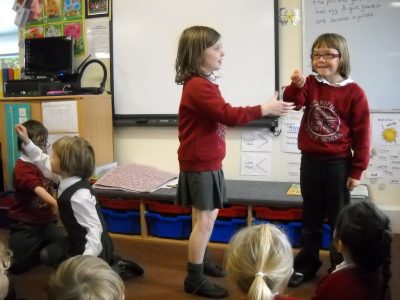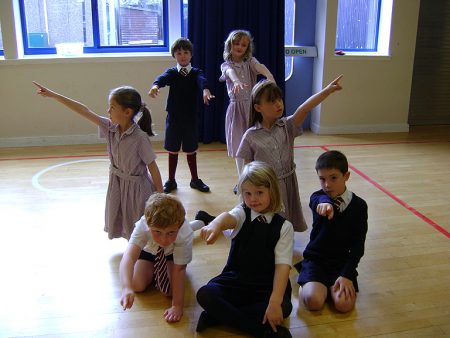The new national curriculum is at first glance a very demanding and difficult document to get your head around. The phrases used are, in many cases, complex and academic in nature and theoretical in practice. Whilst attempts have been made to clarify, with examples, this still leaves large chunks of the curriculum as “great waste bins of unintelligible garbage!”
With all the pressures on teachers to deliver this mass of expectation it is not surprising that for most of the time colleagues are totally focussed on the demands of the curriculum with barely a chance to raise their heads to see beyond the documentation!
As an example of this let me show you the references to Speaking and Listening which appear in the Literacy document:
“All the skills of language are essential to participating fully as a member of society; pupils, therefore, who do not learn to speak, read and write fluently and confidently are effectively disenfranchised.”
However if we trawl through the aims of the Literacy curriculum these two bullet points give a rather narrow example of how this might be achieved.
- use discussion in order to learn; they should be able to elaborate and explain clearly their understanding and ideas
- are competent in the arts of speaking and listening, making formal presentations, demonstrating to others and participating in debate.
Its a similar situation with Drama – where little mention is made:
“All pupils should be enabled to participate in and gain knowledge, skills and understanding associated with the artistic practice of drama. Pupils should be able to adopt, create and sustain a range of roles, responding appropriately to others in role. They should have opportunities to improvise, devise and script drama for one another and a range of audiences, as well as to rehearse, refine, share and respond thoughtfully to drama and theatre performances.”
There is no guidance as to how this might be achieved or which techniques of educational drama might be appropriate for different age ranges.
It is encouraging to know that, however short the mention made for each of these areas of the Literacy curriculum – at least they do get a mention (Speaking and listening being omitted in some previous curricular drafts!)
The fact that there is little guidance, may in fact be an advantage, in that,it gives us carte blanche to approach these in any way we like!

As I have said – the danger with the whole of the new national curriculum is its intensity. It has the potential to swamp teachers with its demands and expectations. This often results in a feeling of “siege mentality” where colleagues do not feel in control of the teaching and learning elements in their classroom practice.
Perhaps it is now time to make the curriculum fit in with what you feel is important; rather than the other way around!
Two exciting areas that are easily introduced into Literacy are Speaking and Listening and Drama. Both give unlimited scope and choice in approach and can provide a fresh and new impetus to you class literacy. Basically the only limits are your own imagination and courage!
Speaking and Listening:
This one was probably an easier one for me as I am not by nature very artistic.
If this is a new introduction into your class timetable don’t be surprised to find that it may take a little time to get established and for the children to become conversant with how it works and what they have to do….so stick with it and don’t get discouraged if its not “amazing” from the start!
You can either directly introduce speaking and listening as a timetabled slot or make definite efforts to identify and promote it within other curriculum subjects.
Here’s a few examples:
- Group work – reporting back or presenting findings from work
- Class discussions – possibly in response to something happening in school / class or maybe through issues raised in another subject
- Class discussions/ opinions on “world events” – information and opinions (see previous article)
- Opportunities for class decisions / votes …why choices are made?
- Pupil presentations
- Oral story telling activities
The list and opportunities for Speaking and Listening are enormous – but raising its profile in your classroom and actively engaging the children in these activities has huge advantages for every pupil both from a personal and an academic point of view.
Let me just go into a little more detail as regards an activity which proved successful in my classroom.
Presentations: This was a deliberately set up as a speaking and listening format in class with also an element of organisational skills thrown in!
The children were asked to choose a partner and to think of and prepare a presentation on whatever topic they wished. The presentation was to last for at least 5 minutes and no longer than 10 mins. They could bring in things to show, make posters and use memory stick to show photos etc.
Each week we would hear 2 presentations and the next weeks presenters would be chosen. I would give feedback and a mark at the end of the presentations.

I have to say it went really well – the children (I have used this with all classes from Y2 upwards) really enjoyed doing it and came armed with all sorts of things to show, posters made and we enjoyed video clips of horse-riding, swimming and kite flying amongst others. We even had to clear the class tables back for a demonstration of skate board moves!
Did it achieve what we set out to do – of course….and more . Was it enjoyable and fun – absolutely!
Drama: The use of drama is a great addition to the Primary curriculum and the elements involved are numerous. If you’re like me and not very artistic in this format then I would recommend that you read a few simple books before you start which will give you some ideas about structure and approach.
(Learning through Drama in the Primary Years – Author.. David Farmer is a good starting point to look at although there are many other texts that can be used)
Your classroom drama can be either taught independently as a topic in its own right, or incorporated in a cross curricular theme through the termly topic or linked to a particular subject.
There are many ways to introduce drama as both an experience and expressive art and you will be best guided through books such as the one above.
I have used drama both independently and in a cross curricular manner and found both approaches to be fun and exciting for the children whilst at the same time developing both their personal skills across a variety of areas and reinforcing and consolidating both academic skills and knowledge.
Personally I did not take my class drama beyond my capabilities – so we never put on full blown plays or presentations. As a class we did perform short scenes in assemblies but that was the limit of our experience. We also did not extend things to costumes but I did find that simple masks gave the children the identity they needed when “in role”.


In concluding – It is not really the exact purpose of this article to give you specific ideas that you can use in your classroom . Rather the examples given are simply that – examples of a couple of things I have used in my classrooms.
What I am trying to say is that it is ok to step back from the ever present demands of the curriculum and to think outside the day to day programmes that perhaps you find yourself repeating. Elements such as these given here and many others provide many facets of the curriculum but in a new, refreshing and exciting format and sometimes we need to step back and be courageous enough to shake things up a little.
Take it from me – have a go, and not only will the children love doing it but you will also.
Charles



